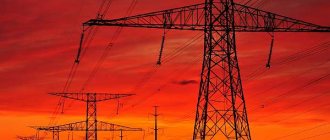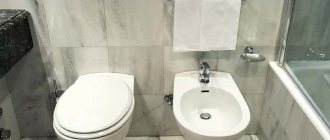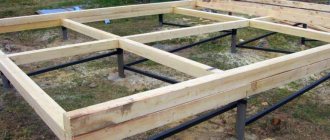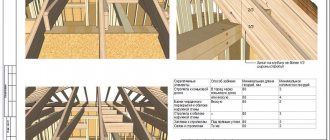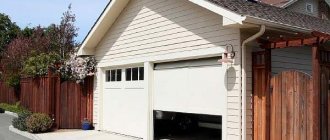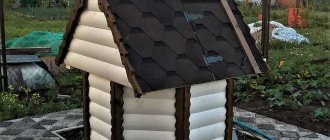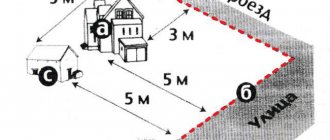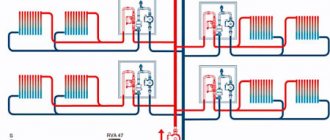Dangerous power line radiation comes from high-voltage networks. Previously, SanPiN standards were approved that established the minimum safe distance from power lines to a residential building, depending on the voltage in the network. Based on this distance, sanitary zones for power lines under high-voltage power lines have been determined and a “burden zone” has been regulated - an area dangerously far from radiation harmful to health. The sale of residential buildings and plots for individual housing construction and SNT in the sanitary zone of power lines in 2021 is strictly prohibited.
Close to residential buildings
Minimum distance from power lines and radiation
As charged particles move through wires, they create an electromagnetic field. The type of electric current determines the properties of radiation. It can be either constant or variable. Frequent changes in electric current from plus to minus and back contribute to a change in the field value several times more often.
Late at night
It has long been known that exposure to electromagnetic radiation negatively affects a person’s physical condition, just like radiation exposure. Observations on the effects of magnetic radiation on humans and the living environment began to be carried out in the early 80s.
Based on the results of a study in various countries, the WHO - World Health Organization established the maximum permissible radiation standards in hertz per unit of time.
In the Russian Federation and other countries, regulations have been approved prohibiting industrial and civil construction at a close distance from power lines.
People who were in the zone of a powerful field for a long time discovered that they had cancer and heart diseases. Women suffered from infertility. Men developed pathologies of the genitourinary system. Chronic fatigue often appeared. Life expectancy in cities and villages has statistically decreased.
Cheapness of land plots in the sanitary zone
Based on SanPiN norms, construction rules were determined and security zones were created under high-voltage lines. Any child care facilities located at a dangerous distance must be closed. It is prohibited to build residential buildings for permanent and temporary residence closer than the distance indicated to high-voltage lines in SanPiN 2971-84.
At the power plant
Please note that it is not possible to sell a house located in a dangerous zone. Sanitary and fire safety organizations will not approve such a document. When developing individual housing construction sites, you need to take into account the distance to the power lines located nearby.
How dangerous the radiation from high-voltage lines is is shown by land prices. The cost of plots near power lines is low. As you move away it rises every 30 meters. Don't be tempted by the cheap price. First of all, you need to think about the health of your family.
How to install correctly
After you decide on the choice of material, you need to calculate at what distance the poles will be from each other, and how many of them you will need in general to provide electricity to the entire area.
For this, there are standards established by electrical engineers. This takes into account the length of the pole and what wire will be used.
From the calculations you can find out how many meters there should be between the pillars. After which, you can begin drilling wells for further installation of pillars in them.
Also, if you need to deviate from the course of the line and, for example, “power” a barn, it is not necessary to install all the same pillars on the way to it. There are small intermediate racks for these purposes. They do not require a support post due to their small size. They can also be used for street lighting in a summer cottage.
Please note: you should not connect the site to the main line yourself, even if you know how to handle electricity! If you connect on your own, you will definitely be fined! Therefore, it is better to obey the demands of the authorities. And then your home will be light and cozy
How to place a support under power lines manually, see the following video:
If you have purchased a country house or are about to start building it, then sooner or later you will be faced with the question of connecting to the electrical network. Often, in connection with this, there is a need to install a power line support near the site. In general, the installation of poles should be carried out by government organizations and this work should be done for free, but in practice everything is not so smooth, and you will have to wait several years. Special organizations can solve this problem for some money.
When hiring specialists, there is no need to delve into the intricacies of the work, but you still need to know certain information. Electricity poles come in three types:
- wooden supports are the cheapest, but not particularly durable;
- reinforced concrete pillars are the most common in use;
- iron power line supports are the most expensive.
Which pole to choose depends on the climatic conditions and the power of the energy consumer.
The approximate cost of installing electricity poles is as follows:
- installation of one pole - 30-35 thousand rubles;
- five pillars - 100 - 120 thousand rubles;
- ten supports – 170 thousand and above.
Let's figure out how these amounts are obtained. Firstly, the cost of installation also includes the price of the pole itself, and secondly, all installation features are taken into account.
Dimensions of the protected area
Let us immediately emphasize that the safe distance from power lines is measured perpendicular to the axis of the overhead line - the high-voltage line. The projection of the outermost wire onto the ground or the outer point of the support structure is taken as the reference point. The width of the sanitary zone depends on the voltage in the wires and is determined by SanPiN 2971-84. Electromagnetic radiation, its background, is measured at a height of 1 m above the soil.
Read: At what distance from a school can you sell alcohol in a store: law 2021
Width of the security zone according to SanPiN standards in 2021
Please note that you cannot build, plant or stay in the sanitary zone for a long time. Land for power transmission lines is prohibited from being sold and used for commercial purposes both in the city and in rural areas, on plots in SNT or individual housing construction.
The mystical meaning of the “devil’s gate”
Another undeniable advantage of reinforced concrete power line racks over wooden and iron racks is their high corrosion resistance when operating in fairly harsh environmental conditions.
Structurally, all electrical insulators differ in the methods of attachment to the supporting structure and cable fastening. The main task of this product is to prevent electrical discharges; for this purpose, they are made in the form of plates or rods with ribs. These ribs are needed so that the discharge develops at an angle to the field lines.
The entire range of building materials from one supplier. Don't waste time calling and searching. Wide range of high quality construction materials. Prompt delivery, convenience and special conditions - everything you need in one place.
By design, there are three main types of overhead line insulators:
- pin;
- suspended linear;
- support and passage.
When choosing lighting masts of a mobile or non-mobile type, it is necessary to take into account the financial and economic part, labor costs for transportation, delivery, installation and the aesthetic component.
According to the requirements of the PUE, the structure must contain only fire-resistant elements that can withstand exposure to an open flame for fifteen minutes. What then about the commonly found wooden poles? It’s simple; before installation, the wood is impregnated with a special compound to make it fire-resistant.
The installation of additional electric poles may be necessary in the private sector, especially if the wooden poles have become unusable. You've probably noticed rotting and rickety wood poles from which power lines run? Previously, only these were installed, but after the expiration of their service life, old samples should be replaced with new ones. It can be wooden, metal reinforced concrete or mixed: a wooden support on a concrete base.
Glass ones, although they are afraid of shocks, but to control their integrity a visual inspection is sufficient, which can be carried out without turning off the voltage. Currently, they are replacing ceramics in overhead power lines and as suspension insulators, including because they weigh less and are also cheaper to produce.
What associations arise when mentioning overhead power lines? Of course, the wires are stretched through the air from support to support or from pillar to post. Moreover, visually, the greater the span between the supports, the higher the wires are stretched, therefore, the higher the support itself should be. In fact, there is no direct relationship between the height of the support and the length of the span.
Pine and spruce are most often used as raw materials for the production of wooden poles. They are least susceptible to rot and insects, unlike other types of wood.
Instructions for installing electricity poles
Before starting the installation process, it is necessary to study the terrain features, which can significantly affect the quality and service life of electricity poles
So, pay attention to the factors:
- natural landscape - where the installation is taking place, for example, in a lowland;
- maximum wind load;
- optimal step between supports.
Safe distance to power lines
The standardized width of the sanitary zone does not correspond to the safe distance standards for housing construction. It is almost 2 times smaller, it is measured not from the outermost wires of the overhead line, but is indicated by one value centered on the axis of the power line. For example, the width of the sanitary zone of a 220 kV line is 25 m. This is approximately 10 m from the support post in one direction. You can build next to power lines no closer than 25 m to the projection of the outermost wire onto the ground.
Sanitary zones of overhead lines
The list shows the safe distance from the house to the power line depending on the voltage in the line:
- 20 kV - 10 m;
- 35 kV - 15 m;
- 110 kV - 20 m;
- 150-220 kV - 25 m;
- 300-750 kV - 30 m;
- 750-1150 kV - 40 m.
2.5.87
The distances between overhead line wires, as well as between wires and cables, must be selected:
1) according to the operating conditions of wires (cables) in spans in accordance with 2.5.88-2.5.94;
2) according to permissible insulation distances: between wires in accordance with 2.5.126; between wires and support elements in accordance with 2.5.125;
3) according to the conditions of protection against lightning overvoltages in accordance with 2.5.120 and 2.5.121;
4) according to corona conditions and permissible levels of radio interference and acoustic noise in accordance with Chapter 1.3, 2.5.81, state standards, building codes and regulations.
The distances between wires, as well as between wires and cables, are selected according to the sag corresponding to the overall span; in this case, the sag of the cable should be no more than the sag of the wire.
In individual spans (no more than 10% of the total), obtained by placing supports and exceeding the overall spans by no more than 25%, an increase in the distances calculated for the overall span is not required.
For spans exceeding the overall dimensions by more than 25%, the distances between wires and between wires and cables should be checked in accordance with instructions 2.5.88-2.5.90, 2.5.92-2.5.95, 2.5.120 and 2.5.121, while it is allowed to ignore the requirements of the application tables.
If there are differences in sag, wire designs and insulator strings in different phases of overhead lines, the distances between the wires (cables) in the span must be additionally checked. The check is carried out under the most unfavorable static deviations at standard wind pressure directed perpendicular to the span axis of a given overhead line. In this case, the clear distances between wires or wires and cables for the conditions of the highest operating voltage must be no less than those specified in 2.5.125 and 2.5.126.
Health hazards from power lines
However, a voltage of 10 kV is considered safe for humans. It creates a background density not exceeding 10 μT (measured in microtesla). For comparison, the Earth's magnetic field is 30–50 μT.
Prohibited in the security zone of power lines
It differs from the radiation generated by overhead lines in that it has a constant or smoothly varying value. A current with a frequency of 50 Hz passes through the power line - this means that per second the current changes its direction 50 times, a complete oscillation occurs - an alternating current wave. The magnitude of the emitted magnetic field also changes with this frequency.
Note that the highest value of natural vibrations reaches 40 Hz. When constantly in the zone of magnetic waves with high levels, malfunctions occur in the human body. This is possible not only when standing under power lines for a long time, but also next to household electrical appliances, especially thermal ones. The damage caused by the proximity of overhead lines can be compared with the health damage caused by a hairdryer, refrigerator, washing machine or laptop.
What you need to pay attention to
In the European Union countries, it is generally accepted that if the voltage in the power line wires is higher than 35 kV and the apartment is located closer than the standard size of the security zone plus 20 m, then, according to the health standards of the United Europe, such proximity can lead to a number of diseases of the nervous and cardiovascular systems .
Standard distances from supports
The distance from power lines and possible harm to health in such a case are absolutely dependent. Construction of housing in the European Union is permitted at a distance of 20 meters from the sanitary protection zone, if we take its value from Russian PUE standards.
All-Russian standards for the distance to residential buildings are stated above in this article.
Below is a table of European standards.
Read: At what distance from the fence can you build a bathhouse: SNiP norm 2020-2021 in SNT and individual housing construction
| Voltage, kV | Security zone according to PUE, m | EU norm for construction, m |
| 35 | 15 | 35 |
| 110 | 20 | 40 |
It is necessary to note that the site for individual housing construction or a dacha may partially be closer to the high-voltage line than the minimum distance to the residential building. In the technical passport this strip is indicated as an encumbrance zone. On this land you can plant a vegetable garden, a garden and put up a fence. You cannot build a house and construct outbuildings. A seating area in the yard should be located away from power lines.
Installation
The rules for installing reinforced concrete supports are determined by GOSTs and SNiPs and are the same for both Moscow and other regions of Russia.
The support is assembled on a flat area cleared of foreign objects. For heavy structures, 35 kV and more attract riggers.
Most often, installation is carried out using technological maps, which contain the sequence of operations, the necessary devices, and the layout of parts (crossbars, traverses, racks).
The procedure for assembling single-post supports made from vibrating racks for power lines up to 10 kV:
- In order to secure the traverse and the grounding descent, the top of the product is raised. The braces and traverses are put on the bolts, the nuts are installed and tightened.
- Before installing the insulators, polyethylene caps are filled. The insulators are mounted and the nuts are cored.
- At the end, a stencil poster is installed, where the year of installation and serial number are indicated.
The supports are lifted using a crane, helicopter or by building up. Before installation, the correct preparation of the foundation and pits is checked.
For different lines, supports of different types and sizes are used.
Overhead lines up to 1 kV
On overhead lines less than 1 kV, the following supports are installed:
- single-column free-standing unified intermediate;
- A-shaped end, anchor, corner;
- single-post with struts;
- prefabricated from vertical posts installed side by side.
It is possible to assemble and install reinforced concrete supports from vibrating racks, which are made to hang 2-4 radio wires and 2 to 9 overhead line wires.
Such structures have steel traverses. They are also used as lighting supports, placing lamps, brackets for branches, and cable sleeves on them.
Overhead lines up to 10 kV
For overhead lines from 6 to 10 kV, installation of single-column products with struts and intermediate, anchor, end and corner - A-shaped products is carried out.
Structures made from vibrating START poles have a traverse, which is made for hanging 3 wires up to 120 mm² made of aluminum.
On anchor and corner single-post supports with struts, steel traverses are placed for the wires of each phase.
On intermediate single-post supports made of centrifuged posts, apical pins and traverses made of wood 80*100 mm are placed.
Overhead line 35-500 kV
On lines of 35 kV and above, portal and single-column free-standing supports unified with guy wires are used.
Their structural parts are cable supports, traverses and pillars, which have asphalt-bitumen waterproofing.
To prevent moisture from entering the rack, plug covers are installed, the bottom of which is an additional way to increase the support area and the strength of the structure in the ground.
There are holes in the upper part of the post for attaching traverses. The grounding slope is laid inside the concrete.
The coupling fittings (brackets and earrings) are secured using rollers, clamps and special brackets installed in the holes provided in the cable stands and traverses. Metal cable supports are attached to the poles with clamps.
Portal single-column supports with metal traverses are installed on 330-500 kV power lines as intermediate ones.
For a 35-220 kV line, intermediate structures with cylindrical and conical posts, 2- or 1-circuit, free-standing single posts are used.
Anchor corner structures are made in the form of reinforced concrete products with guys for 35-110 kV overhead lines.
Determining power line voltage
When purchasing a plot, it is important to make sure that the distance to the overhead line - high-voltage line - is safe. Information about exactly what voltage is on a nearby power line is not always readily available. You can determine it yourself by the number of wires in the bundle and insulator disks near the pole.
Rules for the location of overhead lines on sites in SNT and individual housing construction
One wire means that the consumer voltage is less than 330 kV with a frequency of 50 Hz. A higher value can be determined by the number of wires in the cable bundle:
- 1 PC. — up to 330 kV;
- 2 pcs. — 330 kV;
- 3 pcs. — 500 kV;
- 4 things. — 750 kV;
- 6-8 pcs. - from 1000 kV.
You should not count the number of cables running between the supports, but the wires in one bundle. You can also navigate by the altitude at which they are stretched: the higher they are located, the greater the tension in them.
If there is one wire in the line, then the voltage is determined by the number of insulators - ceramic disks in one branch hanging from the power line pole. Regulatory figures are given in the list:
- 3-5 insulators - 35 kV.
- 6-8 insulators - 110 kV.
- 15 insulators - 220 kV.
Typical voltage in residential areas
On the streets within residential areas, power lines have a voltage of 6–10 kV, which does not create radiation exceeding a value that is safe for humans. These wires are brought into houses, passing over the fences of the plots.
Options for power line supports depending on voltage
Standards for safe use have also been developed for them. According to SNiP, residential buildings and other buildings must be located no closer than 5 meters from the red line. This is the front boundary of the site. All underground and overhead communications pass through it, including power lines. Only a wire connected directly to the building violates the safe distance.
Some connection features
The insulator on which the wire is attached outside must be located on the wall of the building at a height of 2.75 meters or higher. The entrance to the house should not be located above or next to bedrooms, children's rooms and rooms where the family spends a lot of time. The best option is the wall of a pantry, utility room, or hallway.
The minimum sag of SIP over the pedestrian path is 3.5 meters. The sag of the wire between the overhead line poles must be more than 6 m from the ground above the roadway.
In the countryside
In the private sector, the power line runs along one side of the street - the red line on the plan. The distance from the power line to a private residential building on individual housing construction land must strictly comply with the PUE standards.
Read: Distance from the fence to the neighbor’s buildings: new SNiP standards 2020-2021 at the dacha, in a private house
Wires to connect the house from the opposite side must only be pulled through additional supports. The height to the insulators exceeds 6.2 meters. The minimum distance from 6 kV power lines to trees is 2 meters horizontally.
Watch a video on this topic.
Connecting electricity from the pole to the house
Specialized companies are engaged in connecting the cable from the power pole to the distribution box of the house. Before contacting specialists, owners of private houses need to obtain permission from an organization that deals with the supply and connection of electricity. It is necessary to study all the requirements for connecting a private building to the electrical network.
Connection diagram in the village, SNT and individual housing construction
To connect a home, it is necessary to prepare a complete description of the home electrical network with calculations of the power and mode of each pantograph. Based on this project, a permit will be issued.
Methods of protection against electromagnetic radiation
As you gradually move away from the power line, magnetic radiation decreases. SanPiN indicates the distance when it reaches an acceptable value, but does not disappear completely. Professionals say that a completely safe distance is 10 times the permissible distance.
Layout of poles next to a residential building
Additionally, the house has wires and electrical appliances. During operation, they also emit electromagnetic waves at a distance of up to 2 meters from the compressor and heating elements.
The most dangerous are irons and refrigerators. People receive a large share of radiation from televisions, since they spend a long time in front of them. As a result, all radiation is summed up, and the result is a value that exceeds what is safe for humans.
Residential buildings located closer than 100 meters from household voltage lines and 200 meters from high-voltage lines must be protected from electromagnetic radiation.
The main factors in determining the span between lamp posts
The main factor in determining the distance between lighting supports according to SNiP is the formation of intersecting lighting cones. Taking this into account, when calculating, it is necessary to take into account the following parameters:
- required illumination in the area where installation will be carried out (city center or outskirts, country house or village);
- power and type of light sources, as well as their number;
- type of installed lenses on LED matrices;
- the height of the lighting source on the support.
The diagram shows most of the data that is necessary to determine the spacing of lighting supports. Among the parameters:
- height of suspension of the LED lamp on supports H (m);
- pitch of mast supports along the road L (m);
- extension of the center of the lamp from the edge of the roadway l (m);
- roadway width W (m);
- angle of inclination of the console with the lamp α (°).
The higher the lighting device is on the pole, the less illumination will be at the level of the road surface. In this regard, the distance between two pillars on the road will decrease and vice versa. The figure below shows as an example how the degree of illumination of a surface that is located at a certain distance from the light source changes.
The same dependence is observed when the installation height of light sources on lighting supports is increased.
